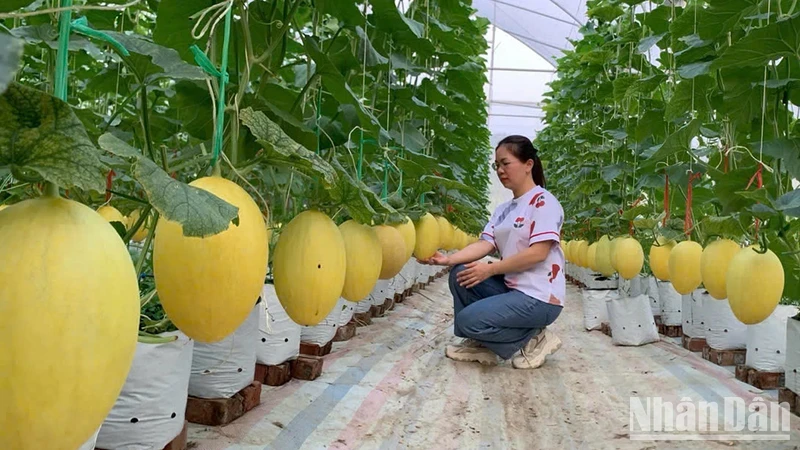Building new-style rural areas is a priority for localities nationwide, especially in mountainous provinces and underdeveloped regions.
Overcoming challenges and advancing
The new-style rural area development programme places people at the centre as the primary beneficiaries, thus encouraging widespread participation. According to the Coordination Office of the New-Style Rural Area Development Programme, as of July, 6,289 out of 8,162 communes (77.1%) nationwide had met standards set for new-style rural areas. Of these, 2,146 communes achieved advanced standards, and 465 were recognised as exemplary new-style rural areas.
While the programme has yielded promising results, challenges remain, such as disparities in economic conditions, infrastructure, and education levels across regions. However, these difficulties have not deterred provinces from progressing. Using unique approaches, localities have steadily met new-style rural area criteria.
For instance, Bac Kan City, a mountainous area with many difficulties, achieved new-style rural area status in 2022, thanks to the efforts of both authorities and residents. By the end of June 2024, Bac Kan Province had 28 communes meeting new-style rural area standards, four achieving advanced standards, and 70 villages recognised as new-style rural villages. On average, the province met 12.79 criteria per commune.
This progress, though modest, reflects the tremendous efforts of the provincial authorities and local ethnic communities. Bac Kan City, comprising six wards and two communes (Nong Thuong and Duong Quang), faced challenges despite being the province’s political, economic, and social hub.
Before 2015, Nong Thuong (then a commune of Bac Kan Town) reflected the typical characteristics of remote, upland villages. Residents depended on small-scale agricultural and forestry production, and environmental concerns were neglected. However, collective efforts and determination across the political system led to a shift in perception and action regarding building new-style rural areas.
In just two years, by 2017, Nong Thuong became one of Bac Kan’s first communes to meet new-style rural area standards. By 2023, it achieved advanced new-style rural area status.
The swift, sustainable attainment of new-style rural area standards in Nong Thuong resulted from addressing two challenging criteria: the environment and income. Waste disposal into streams ceased, centralised waste collection points were established along main roads and urban environmental services were introduced. According to Ms Dao Thi Bay of Na Choong Village, families now collect waste for designated pick-up points, and monthly village clean-ups take place on the 20th.
Chairman of Nong Thuong Commune’s People Committee, Trieu Van Nhuc, stated that income remains the most challenging criterion, as about 60% of households rely on agriculture and forestry. To address this, the commune promoted concentrated agricultural models, applied scientific and technical advances, and supported high-value crop cultivation. Additionally, residents were encouraged to access loans for production and business development.
These policies have yielded results, with two local enterprises now employing advanced agricultural production and processing technology. The commune currently has only 28 poor households (3.11%) and 28 near-poor households (3.07%), with a per capita income of over 54 million VND in 2023.
Preserving cultural identity
According to Nguyen Duc Thinh, Head of the Economic Department of Bac Kan City, the city has directed resources to address shortcomings, develop effective production and business models, and improve residents’ incomes in the two communes. It has also attracted investment to create agricultural and forestry production zones linked to eco-tourism and rural experiences. Pilot environmental improvement projects are underway in rural tourism villages like Ban Pen and Ban Bung in Duong Quang Commune for the 2024–2025 period.
Since achieving new-style rural area status in 2019, Duong Quang has seen improved rural landscapes and living standards. The commune now hosts six active cooperatives, with a 2023 per capita income exceeding 52 million VND. All villages have cultural centres, 100% of rural roads are paved, 90% of irrigation canals are reinforced, and all households have access to electricity.
Focusing on environmental sustainability, Duong Quang has mobilised residents to maintain a green, clean, and beautiful environment through initiatives such as “Five Nos, Three Cleans” and “Clean Homes, Productive Fields”. The commune has also established cultural clubs, organised traditional performances, and developed eco-tourism attractions like flower fields and agricultural tourism.
Bac Kan City planned to invest 8 billion VND in new-style rural area development efforts in 2024, targeting an average income of over 55 million VND per capita, a multidimensional poverty rate below 4% and enhanced rural living standards. Duong Quang aims to achieve advanced new-style rural area status in 2025, while Nong Thuong aspires to become an exemplary new-style rural commune in 2025. By 2030, 100% of communes are expected to meet exemplary standards.
Ngo Truong Son, Chief of the Coordination Office of the New-Style Rural Area Development Programme, emphasised the need to prioritise investments in basic infrastructure for disadvantaged areas, especially essential village-level facilities, inter-communal roads, and irrigation and clean water systems. Developing rural commerce and tourism infrastructure will further integrate upland and lowland economies.
With the joint efforts of the government and citizens, Bac Kan is on track to create a rural region rich in cultural identity and a desirable place to live.
















